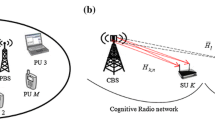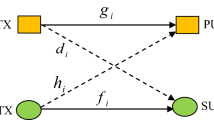Abstract
This work investigates power allocation algorithms for capacity maximization of a non-contiguous orthogonal frequency division multiplexing (NC-OFDM) based cognitive radio (CR) user coexisting with multiple active primary users (PU), under total power budget, sub-channel power and overall interference constraints. Based on the spectral distance between specific subcarriers and PU bands, the scheme allocates power among a minimum number of PU adjacent subcarriers with a water level that is different from the ‘far-away’ subcarriers. The proposed ‘n-adjacent’ approach is subjected to both aggregate and individual PU band interference constraint. Unlike some of the existing methods, the proposed method is capable of meeting the constraints including the contribution of ‘good quality’ subcarriers even when they are close to PU bands. Comparison of results for a wide range of power budget shows that the improved method, using the same complexity, can achieve higher cognitive user capacity with greater power allocation efficiency.







Similar content being viewed by others
References
Mitola, J. (1999). Cognitive radio for flexible mobile multimedia communications. IEEE international workshop on mobile multimedia communication (pp. 3–10). McLean, VA, USA.
Federal Communication Commission. Spectrum policy task force report FCC Report 2002, ET Docket, 02–135.
Haykin, S. (2005). Cognitive radio: Brain-empowered wireless communications. IEEE Journal on Selected Areas in Communication, 23(2), 201–220.
Hossain, E., Niyato, D., & Kim, D. I. (2013). Evolution and future trends of research in cognitive radio: a contemporary survey. Wireless Communications and Mobile Computing. doi:10.1002/wcm.2443.
Mahmoud, H. A., Yücek, T., & Arslan, H. (2009). OFDM for cognitive radio: Merits and challenges. IEEE Wireless Communication, 16(2), 6–15.
Weiss, T., Hillenbrand, J., AKrohn, A., & Jondral, F. K. (2004). Mutual interference in OFDM-based spectrum pooling systems. IEEE VTC, 4, 1873–1877.
Zhang, H., Ruyet, D. L., & Terre, M. (2009). Spectral efficiency comparison between OFDM/OQAM- and OFDM-based CR networks. Wireless Communications and Mobile Computing, 9(11), 1487–1501.
Pao, W. C., & Chen, Y. F. (2014). Adaptive gradient-based methods for adaptive power allocation in OFDM-based cognitive radio networks. IEEE Transactions on Vehicular Technology, 63(2), 836–848.
Cover, T. M., & Thomas, J. A. (2006). Elements of information theory. New Jersey: Wiley.
Bansal, G., Hossain, M. J., & Bhargava, V. K. (2011). Adaptive power loading for OFDM-based cognitive radio systems with statistical interference constraint. IEEE Transactions on Letters, 10(9), 2786–2791.
Zhang, Q., Feng, Z., Yang, T., & Li, W. (2015). Optimal power allocation and relay selection in multi-hop cognitive relay networks. Wireless Personal Communication, 86, 1673–1692.
Benaya, A. M., Shokair, M., El-Rabaie, E. S., & Elkordy, M. F. (2015). Optimal power allocation for sensing-based spectrum sharing in MIMO cognitive relay networks. Wireless Personal Communication, 82, 2695–2707.
Rasouli, H., Kong, H. Y., & Anpalagan, A. (2014). Cooperative subcarrier allocation and power allocation in the downlink of an amplify-and-forward OFDM relaying system. Wireless Personal Communication, 79, 2271–2290.
Zhang, Y., & Leung, C. (2009). Resource allocation in an OFDM-based cognitive radio system. IEEE Transactions on Communications, 57(7), 1928–1931.
Zhang, T., Chen, W., Han, Z., & Cao, Z. (2014). Hierarchic power allocation for spectrum sharing in OFDM-based cognitive radio networks. IEEE Transactions on Vehicular Technology, 63(8), 4077–4091.
Biyanwilage, S., Gunawardana, U., & Liyanapathirana, R. (2014). Power allocation in OFDM cognitive radio relay networks with outdated channel state information. International Journal of Communication Systems. doi:10.1002/dac.2755.
Peng, J., Li, S., Zhu, C., Liu, W., Zhu, Z., & Lin, K. C. (2015). A joint subcarrier selection and power allocation scheme using variational inequality in OFDM-based cognitive relay networks. Wireless Communications and Mobile Computing. doi:10.1002/wcm.2581.
Shaat, M., & Bader, F. (2010). Computationally efficient power allocation algorithm in multicarrier-based cognitive radio networks: OFDM and FBMC systems. EURASIP Journal on Advances in Signal Processing. doi:10.1155/2010/528378.
Gupta, J., Karwal, V., & Dwivedi, V. K. (2015). Joint overlay-underlay optimal power allocation in cognitive radio. Wireless Personal Communication, 83, 2267–2278.
Chen, Y., Lei, Q., & Yuan, X. (2014). Resource allocation based on dynamic hybrid overlay/underlay for heterogeneous services of cognitive radio networks. Wireless Personal Communication, 79, 1647–1664.
Mao, J., Xie, G., Gao, J., & Liu, Y. (2013). Energy efficiency optimization for OFDM-based cognitive radio systems: A water-filling factor aided search method. IEEE Transactions on Wireless Communications, 12(5), 2366–2375.
Vinh, N. V., Shouyi, Y., & Tran, L. C. (2014). Power allocation algorithm in OFDM-based cognitive radio systems (pp. 13–18). Da Nang: GLOBECOM.
Kang, X., Garg, H. K., Liang, Y. C., & Zhang, R. (2010). Optimal power allocation for OFDM-based cognitive radio with new primary transmission protection criteria. IEEE Transactions on Wireless Communications, 9(6), 2066–2075.
Sahin, A., & Arslan, H. (2011). Edge windowing for OFDM based systems. IEEE Communications Letters, 15(11), 1208–1211.
Wang, P., Zhao, M., Xiao, L., Zhou, S., & Wang, J. (2007). Power allocation in OFDM-based cognitive radio system. In Global Telecommunications Conference, 2007. GLOBECOM '07. IEEE (pp. 4061–4065). Washington, DC: IEEE.
Hasan, Z., Bansal, G., Hossain, E., & Bhargava, V. K. (2009). Energy-efficient power allocation in OFDM-based cognitive radio systems: A risk-return model. IEEE Transactions on Wireless Communications, 8(12), 6078–6088.
Rajbanshi, R., Wyglinski, A. M., & Minden, G. J. (2007). Cognitive radio communication networks, Ch. 5. New York: Springer.
Boyd, S., & Vandenberghe, L. (2004). Convex optimization. Cambridge: Cambridge University Press.
Bepari, D., & Mitra, D. (2015). Improved power loading scheme for orthogonal frequency division multiplexing based cognitive radio. IET Communications, 9(16), 2033–2040.
Bansal, G., Hossain, M. J., & Bhargava, V. K. (2008). Optimal and suboptimal power allocation schemes for ofdm-based cognitive radio systems. IEEE Transactions on Wireless Communications, 7(11), 4710–4718.
Author information
Authors and Affiliations
Corresponding author
Appendix: Proof of Theorem 1
Appendix: Proof of Theorem 1
We use the fact that maximizing a concave function (3) is nothing but a minimizing of its negative value. Considering the Lagrange parameters λ, β j , δ and μ i for (i), (ii), (iii) and (iv) inequality constraints of (3) respectively. The KKT conditions are written as [28]
and
where \(h_{i} = \frac{{\left| {G_{i}^{ss} } \right|^{2} }}{{\sigma_{2} + \gamma_{i} }}\). From (18) it can be written that
Now, substituting (19) into (17)
and substituting (19) into (13)
From (21), P i > 0 if λ + β j,ϕ(i) + δα i < h −1 i and from (20) P i expressed as \(P_{i} = \frac{1}{{\lambda + \beta_{j,\phi \left( i \right)} + \delta \alpha_{i}}} - h_{i}^{ - 1}\). On the other hand, if λ + β j,ϕ(i) + δα i ≥ h −1 i then due to violation of (20), P i > 0 is impossible and the only solution is P i = 0. Combining these two results, the solution is expressed as
The theorem is proved.
Rights and permissions
About this article
Cite this article
Bepari, D., Bojja, A.K., Kumar, B.S. et al. A Spectral Distance Based Power Control Scheme for Capacity Enhancement of OFDM Cognitive Radio. Wireless Pers Commun 90, 157–173 (2016). https://doi.org/10.1007/s11277-016-3337-2
Published:
Issue Date:
DOI: https://doi.org/10.1007/s11277-016-3337-2




